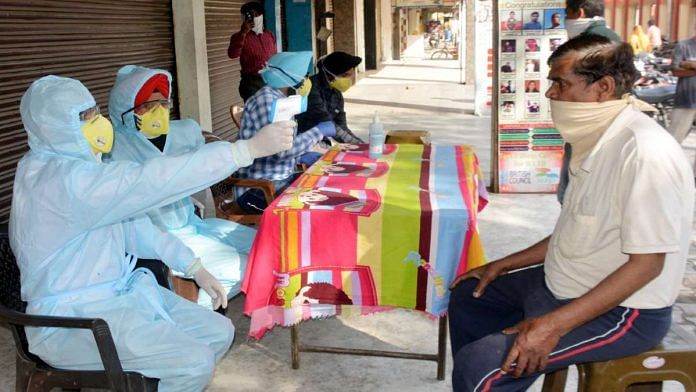Amritsar: It is not evident at once when you go over the state-wise data for Covid-19 released by the Union Ministry of Health & Family Welfare. The numbers for Punjab (277, as of Friday) are far lower than those for other areas like Gujarat (2,624), Maharashtra (6,430) and Delhi (2,376).
But a look at the number of deaths throws fresh light on the Covid-19 situation in Punjab, where the disease has so far killed 16 people, or 5.7 per cent of the people infected. The death rate is 4.2 per cent for Gujarat (where 112 people have died), 4.4 per cent in Maharashtra (283 deaths) and 2.1 per cent for Delhi (50). The national average stood at 3.1 per cent as of Thursday.
Punjab, which diagnosed its first case of Covid-19 in the first week of March, currently has the highest rate of death in the country, even though it has come down from a peak of 7.6 per cent earlier this month.
Why this is so is a question that doesn’t have clear answers yet. While doctors and the state government blame comorbidities and patients seeking hospital treatment late, questions have also been raised about the state’s medical infrastructure.
Also Read: Shunned by hometown, Sikh spiritual singer who died of Covid-19 cremated in secluded area
‘Comorbidities, late treatment’
Earlier this month, four staffers of the Government Medical College in Amritsar were issued showcause notices for going public with allegations that the facility was short of personal protective equipment (PPE) for doctors and other health workers.
On 2 April, Sikh spiritual singer Nirmal Singh Khalsa, a Padma Shri awardee, died of coronavirus in Amritsar amid allegations that, he was turned away by hospitals for many days without being tested despite showing symptoms. Sources in the Amritsar government medical college had told ThePrint at the time that nobody suspected him to be a coronavirus patient because he had no travel history and hadn’t come in contact with a patient either.
There were also allegations that he hadn’t received proper medical care.
Medical negligence has also been alleged in the death of a 42-year-old woman, who reportedly died after undertaking an hours-long journey to Patiala from Ludhiana to access ventilator support.
However, Raman Sharma, the medical superintendent at the Amritsar government medical challenge, dismissed allegations that the high death rate could be attributed to gaps in the state’s healthcare infrastructure.
Asked why the rate of death was higher in Punjab than in other states, Sharma claimed the “patients were diagnosed and brought to the hospital late and a lot of them have comorbidities”.
“When the guidelines (on treatment) were not clear, there were treating problems. This disease is new, everybody knows very little about it. We are all in the learning stage right now,” he said.
Dr Manjit Singh Bal, former head and professor at Government Medical College Patiala, offered a similar explanation in a report published in The Tribune earlier this month.
“We have to consider the age-demographics and immunity level of the people in the respective area to get the exact reason for the high percentage of deaths from Covid-19 in Punjab,” he had said.
In a press release issued by the Chief Minister’s Office Friday, Captain Amarinder Singh said the state’s mortality numbers “are high largely due to comorbidity and lack of health-seeking behaviour (patients come late to hospital)”.
The release, however, also notes the fact that the rate of growth for Covid-19 in Punjab is lower than that of other states, with cases doubling every 16 days. As of 22 April, Punjab accounted for 1.22 per cent of India’s total coronavirus cases, down from 2.57 per cent on 31 March.
The state government, meanwhile, has also ordered a detailed audit of every coronavirus death to check the mortality rate.
‘Patients treated whole-heartedly’
At the sprawling campus of the government medical college in Amritsar, the first to begin testing and treatment for coronavirus in Punjab, the mood is grim. Hallways that were once crowded with students and professors discussing class material are now occupied by stray dogs basking in the sun.
Everyone on campus has a mask on — there is no time for a lazy stroll through the corridors, and the staff is shuffling past with a sense of purpose. Behind closed doors, meetings are under way — meetings that often go on through the day — to discuss ways to tackle the situation at hand.
With 200 beds — which are expected to increase to 300 in a few days, Sharma said — 21 ICU beds and 13 ventilators, 171 nurses, 200 ward boys and 200 safai saveks (sweepers), the government medical college has been treating and testing Covid-19 patients since 7 March.
A five-storey block at the hospital is dedicated entirely to coronavirus patients.
As of Thursday, the hospital had five patients in the isolation ward. Three had been treated and discharged while four others had succumbed to the virus.
“The three that recovered had comorbidities like hypertension, obesity, diabetes and were of old age,” said medical superintendent Sharma. The same was said for the four who died, but Sharma added, “Most of those who died were reported late and required ventilators. One patient was referred to us from Gurdaspur, he could not survive more than 36 hours. Others remained with us for 5-7 days.”
“They were treated wholeheartedly,” he added.
Also Read: 6-month-old is Punjab’s youngest Covid death, 54 medical staff and family in quarantine



